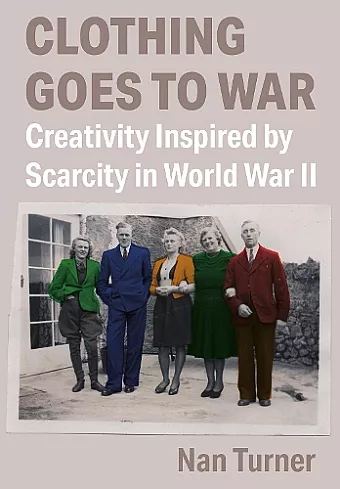Clothing Goes to War
Creativity Inspired by Scarcity in World War II
Format:Paperback
Publisher:Intellect
Published:24th Jun '22
Should be back in stock very soon

Clothing Goes to War: Creativity Inspired by Scarcity in World War II is the story of clothing use when manufacturing for civilians nearly stopped and raw materials and workers across the globe were shifted to war work. Governments mandated rationing programmes in many countries to regulate the limited supply, in hopes that the burden of austerity would be equally shared. Unfortunately, as the war progressed and resources dwindled, neither ration tickets nor money could buy what did not exist on store shelves.
Many people had to get by with their already limited wardrobes, often impacted by the global economic depression of the previous decade. Creativity, courage and perseverance came into play in caring for clothing using handicraft skills including sewing, knitting, mending, darning and repurposing to make limited wardrobes last during long years of austerity and deprivation.
This fascinating page-turner is the first cross cultural account of the difficulties faced by common people experiencing clothing scarcity and rationing during World War II. In person interviews of women from over ten countries are contextualized with stories of the roles played by newly developed textiles, gendered dress in the workplace, handicraft skills often forgotten today, romance and weddings, rationing represented in war era film and the ever-present black market. Period photos from private collections, magazines and periodicals add dimension to this captivating account of the often overlooked role of clothing during World War II.
Clothing Goes to War will appeal to present day readers interested in curtailing their consumption of clothing in an effort to reduce greenhouse gas emissions fueling climate change. Adopting the conservation techniques of the World War II generation who: 'made do' and 'wore our clothes until they wore out' will help to curtail the fashion industries negative impact on the environment.
'We made do.'
'We wore patches on our patches.'
'We wore our clothes until they wore out.'
'I was so excited when they had a feed sack with a border print!'
These are just a few examples of the amazing first-hand experiences of women from over ten countries faced with clothing shortages represented in this book. Governments, regardless of which side they were on, enforced rationing and restrictions on clothing so that scarce textiles could be diverted to outfit the military, leaving...
'Clothing Goes to War is a sound contribution to the ever-expanding body of literature on the interactions between material culture, social history and war. Turner explores the roles of different textiles in war — jute, cotton, wool, nylon and even rubber (never underestimate the prevalence of girdles in wartime) — and the ways in which female ingenuity battled scarcity. Her narrative is a successful interweaving of personal stories and historical analysis, sharing experiences of women across different social classes and nationalities in a way that is both moving and insightful...
The book’s broad overview of national policies on thrift in both Allied and Axis countries, balanced with individual interviews by the author, makes clear that traditional female thrift and women’s unpaid labour were both crucial factors in government economic policies... What sets this book apart from many histories of wartime apparel are the connections made across different classes, races and nations, and the comparison it draws between thrift practices then and now. Turner draws our attention to parallels between wartime crafting necessities and recent pandemic responses. Times of crisis focus consumers on issues of hoarding, scarcity and adaptability — very much features relevant to the Second World War as well as current global issues of conflict and deprivation...
Clothing Goes to War is a call for greater awareness of textile sustainability practices, and a fine tribute to so-called ordinary people who persevered through the hardships of the 1930s and 1940s.'
-- Lucy Adlington, Textile HisISBN: 9781789383461
Dimensions: unknown
Weight: unknown
256 pages